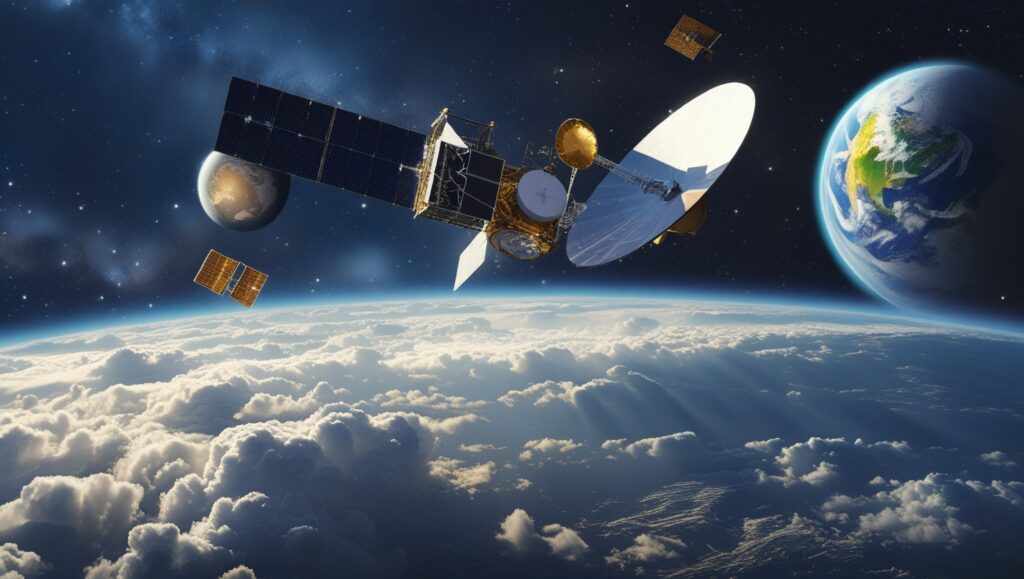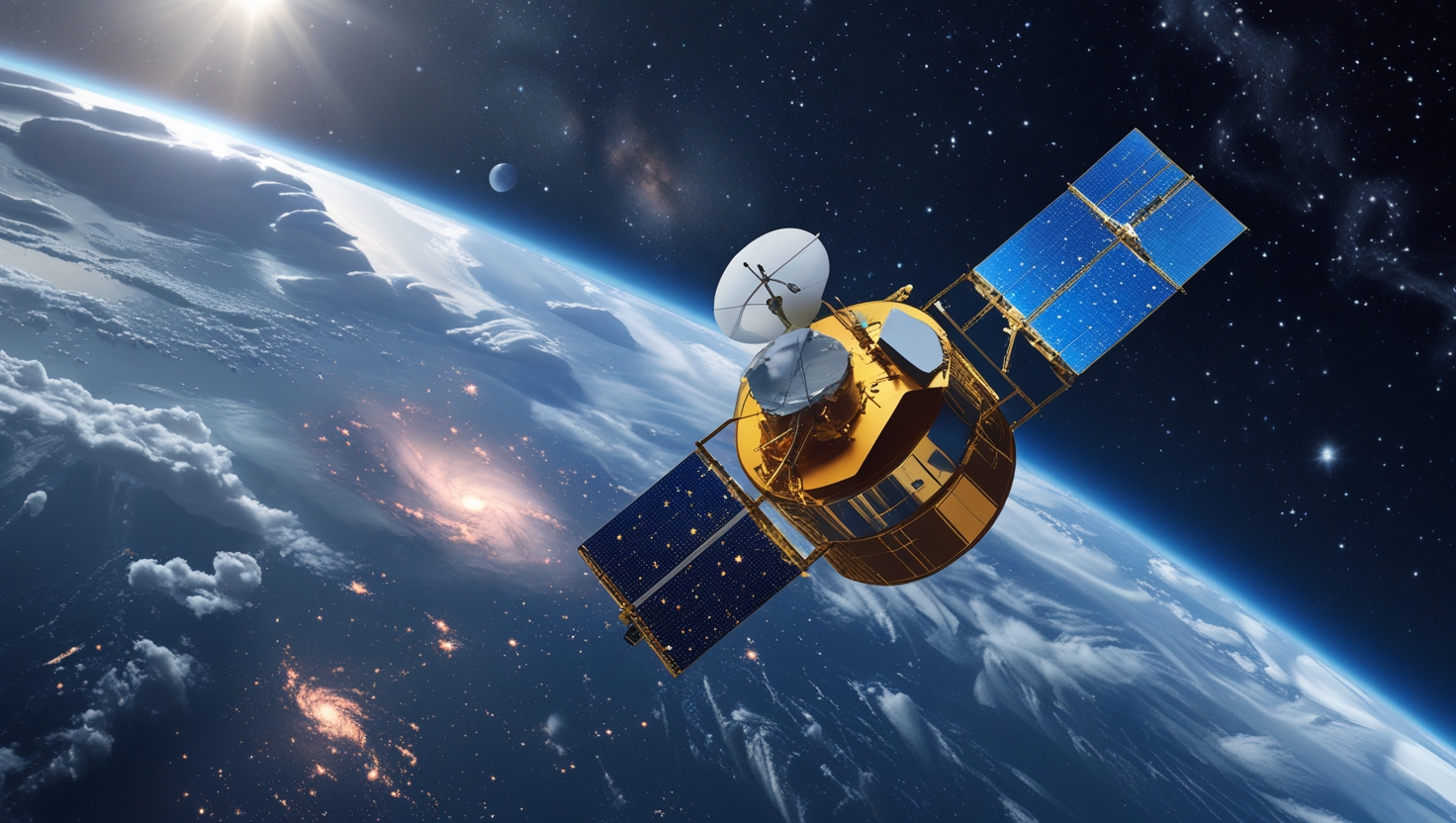Sattelitter are one of the most important technologies in the modern world. We use them every day, even if we don’t realize it. They help us make phone calls, watch TV, find our location, predict the weather, and even study the Earth and outer space.
In this article, you will learn:
- What satellites are
- Types of satellites
- How they work
- What they are used for
- History and major achievements
- How satellites help our everyday life
- The future of Sattelitter
1. What Is a Satellite?
A satellite is any object that orbits around a planet or another large body in space. There are two main types:
- Natural satellites: These occur naturally. The Moon is Earth’s natural Sattelitter.
- Artificial satellites: These are made by humans and sent into space. These are the Sattelitter we usually talk about.
When people say “satellite,” they usually mean artificial Sattelitter—machines launched into space to orbit Earth or other planets.
2. How Do Satellites Work?
Sattelitter are launched into space by rockets. Once they reach a certain height, they are placed into orbit, which means they start moving around the Earth or another object.
Satellites stay in orbit because of two forces:
- Gravity pulls them toward Earth.
- Speed keeps them moving forward.
These two forces work together so the Sattelitter keeps circling the Earth without falling.
Satellites use solar panels to get power from the Sun. They have computers, cameras, antennas, and sensors to do different jobs.
3. Types of Sattelitter
Sattelitter come in many shapes and sizes, depending on what they are made to do. Here are the most common types:
a. Communication Satellites
These satellites send and receive signals for:
- Mobile phones
- Internet
- TV channels
- Radio
They help people connect across long distances—even across the globe.
b. Weather Satellites
These watch the weather from space. They:
- Track storms and hurricanes
- Monitor clouds, wind, and rainfall
- Help predict weather and climate changes
c. Navigation Satellites
These satellites help you find your location. GPS (Global Positioning System) is a group of navigation satellites. We use GPS in:
- Cars and trucks
- Airplanes and ships
- Smartphones and smartwatches
d. Earth Observation Satellites
These study the Earth’s surface. They are used for:
- Watching forests and oceans
- Checking crops and farming
- Disaster management (like floods and wildfires)
e. Military Satellites
Used by governments for:
- Security
- Spying
- Monitoring enemy movements
f. Scientific Satellites
These are used by scientists to:
- Study space and stars
- Research black holes and planets
- Explore the universe
4. How Are Satellites Launched?
To send a satellite into space, a powerful rocket is used. The satellite sits on top of the rocket. After launch:
- The rocket flies upward through the atmosphere.
- Once it reaches space, the rocket drops away.
- The satellite is released into orbit.
- The satellite turns on its systems and starts working.
Launching a satellite is expensive and requires planning, testing, and coordination. Countries like the USA, Russia, China, and India have their own space programs to launch satellites.

5. Orbits: Where Do Satellites Go?
Satellites are placed in different orbits depending on their job:
a. Low Earth Orbit (LEO)
- 200 to 2,000 kilometers above Earth
- Used for cameras, spy satellites, and the International Space Station
- They move quickly and circle the Earth in 90–100 minutes
b. Medium Earth Orbit (MEO)
- 2,000 to 35,000 kilometers high
- Mainly used for GPS satellites
c. Geostationary Orbit (GEO)
- 35,786 kilometers above the Earth
- Stays over the same spot on Earth all the time
- Great for TV, weather, and communication satellites
6. A Short History of Satellites
1957: The first satellite, Sputnik 1, was launched by the Soviet Union. It shocked the world and started the “Space Race.”
1960s–1970s: Communication and weather satellites became common.
1980s–1990s: GPS systems and spy satellites improved.
2000s–Today: Private companies like SpaceX, Amazon, and OneWeb started building satellite systems.
Now, more than 8,000 satellites are in orbit, and more are launched every year.
7. What Satellites Do for Us Every Day
Even if you don’t see them, satellites are helping you all the time. Here’s how:
Communication
They help you:
- Watch international TV channels
- Use your phone in faraway places
- Attend online classes or meetings via the internet
Navigation
They let you:
- Use GPS to find directions
- Track flights or delivery trucks
- Know your exact location
Weather
They help meteorologists:
- Predict rain, snow, and storms
- Save lives by warning people early
- Understand climate change
Disaster Response
After floods, fires, or earthquakes, satellites:
- Provide real-time images
- Help rescue teams
- Guide aid and supplies to the right place
Environment
They track:
- Deforestation
- Melting glaciers
- Ocean pollution
Satellites are like eyes in the sky, helping us care for our planet.
8. Satellites and the Future
Satellites are becoming smaller, cheaper, and smarter. New trends include:
Mini-Satellites / CubeSats
- Small, lightweight, and low-cost
- Can be launched in groups
- Great for schools, startups, and science missions
Mega-Constellations
Companies like SpaceX (Starlink) and Amazon (Project Kuiper) are building networks of thousands of satellites to provide:
- Fast internet in remote areas
- Better global coverage
Artificial Intelligence (AI)
New satellites use AI to:
- Process data faster
- Make decisions without human help
- Detect problems on Earth instantly
Space Tourism & Travel
Future missions to the Moon or Mars will use satellites for:
- Communication
- Navigation
- Safety
9. Problems Satellites Face
Satellites bring many benefits, but there are also challenges:
Space Junk
Old satellites and broken parts stay in orbit and can crash into working satellites. This creates space debris, which is dangerous.
Privacy Concerns
Some people worry about being watched or tracked from space.
Crowded Orbits
With so many satellites, space is getting crowded. It’s harder to manage orbits and avoid collisions.
Cost and Risk
Building and launching satellites is expensive. A failed launch means a huge loss.
Conclusion
Satellites are one of the most amazing inventions of modern times. They help us connect, explore, learn, and stay safe. From TV signals to saving lives during disasters, satellites are a part of almost everything we do.
In the future, satellites will play an even bigger role—helping us bring internet to every corner of the Earth, study the universe, and protect our planet.
As we continue to explore space, satellites will always be our guides, tools, and silent helpers—floating far above us but working every second for the world below.


